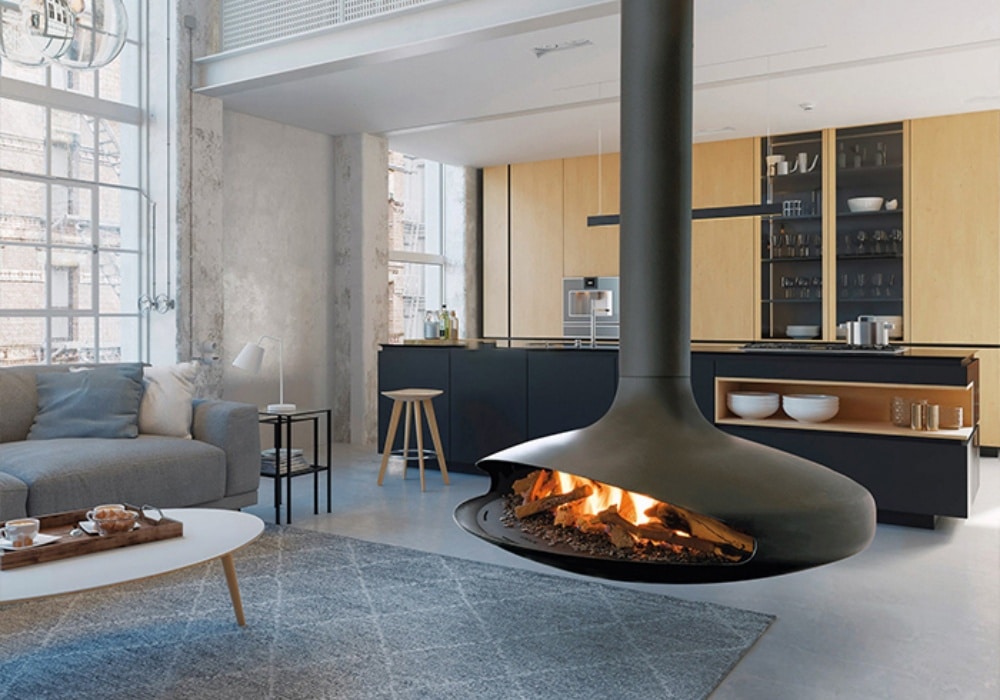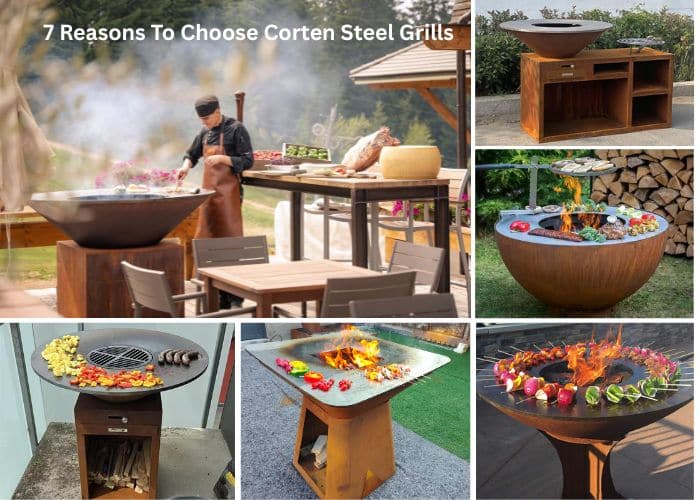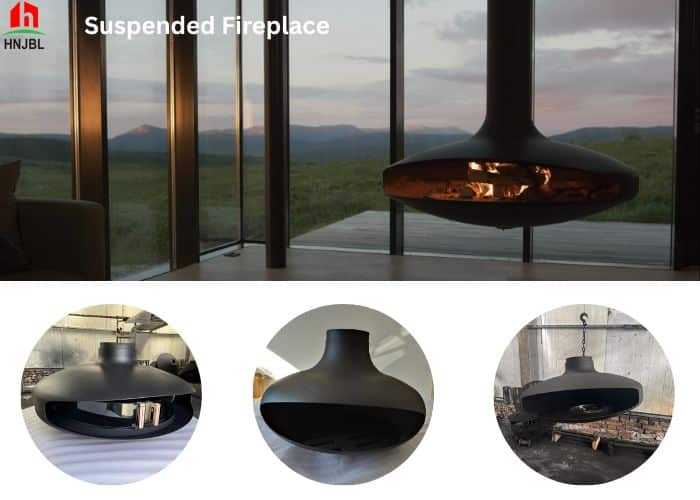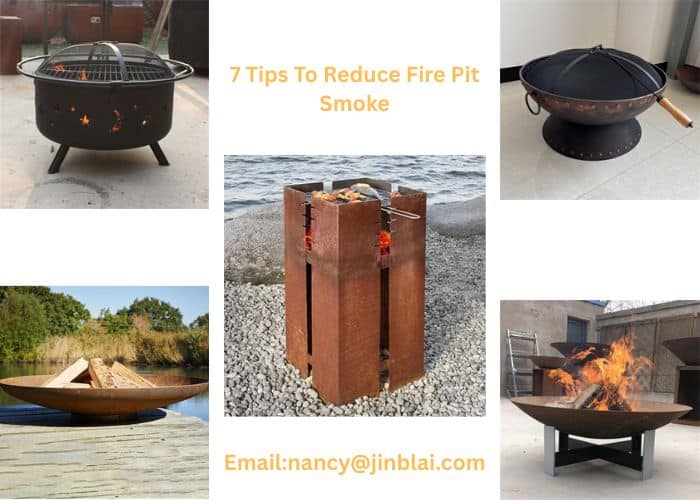In modern home design, hanging wood-burning fireplace is no longer just heating tools, but has evolved into practical and artistic interior decoration elements. The emergence of this hanging fireplace has subverted the design mode of traditional fireplaces fixed on the wall or the ground. Its suspended structure not only saves space, but also gives greater flexibility to interior design.
Indice dei contenuti
Che cos'è un caminetto a legna sospeso?
A hanging wood-burning fireplace is an innovative fireplace that combines modern design with traditional heating methods. It is fixed on the ceiling or load-bearing beam in the form of hanging, completely separated from the ground, thus creating a visual beauty floating in space.
Our fireplace is made of carbon steel and mainly burns wood. The appearance consists of a carbon steel pipe hanging from the ceiling and a hollow semicircular furnace body below.
What is The Design Concept?
The design inspiration of the hanging fireplace comes from the pursuit of spatial freedom. Traditional fireplaces usually occupy a large ground space and are fixed in position, which limits the flexibility of the interior layout. The hanging fireplace maximizes the liberation of ground space by suspending the furnace body in the air and connecting it to the ceiling with only a carbon steel pipe. This design not only makes the fireplace the center of the room, but also allows a 360-degree full-scale appreciation of the dancing flames, creating a dynamic visual effect.
The design of the suspended fireplace fully considers the aesthetic needs of modern people. Its lines are simple and smooth, without cumbersome decorations, in line with the minimalist design trend. The carbon steel pipe hangs from the ceiling like a sculptural pillar, which is both a structural support and a visual extension.

Perché scegliere l'acciaio al carbonio?
Carbon steel is an alloy material based on iron with a small amount of carbon added. It has the characteristics of high strength, corrosion resistance and high temperature resistance. These qualities can withstand the test of long-term high-temperature combustion while maintaining structural stability.
1. Vantaggi fisici dell'acciaio al carbonio
The high strength of carbon steel ensures the safety of the suspended fireplace. The suspended design requires that the supporting structure of the fireplace must be strong enough to bear the weight of the furnace body and burning wood. As the core component connecting the ceiling and the furnace body, the tensile strength and toughness of the carbon steel pipe can effectively prevent deformation or breakage. In addition, the high temperature resistance of carbon steel prevents it from softening or deforming during long-term combustion, ensuring the service life of the fireplace.

2. Effetto visivo dell'acciaio al carbonio
The surface of carbon steel usually presents a cold metallic luster, which forms a strong visual contrast with the warm flame of the wood-burning fireplace. This contrast not only enhances the artistic sense of the fireplace, but also makes it a representative of modern industrial style design.
Some hanging fireplaces use sandblasting or brushing on the carbon steel surface, which further enhances the texture and makes it present a rich sense of layering under different light.
In addition, carbon steel can also present different colors such as white, red, black, etc. through coating or oxidation treatment to adapt to different interior styles.
3. Protezione ambientale e sostenibilità
Although the production process of carbon steel consumes energy, its recyclability makes it a relatively environmentally friendly material. The carbon steel parts of the hanging fireplace can be completely recycled and reused after being scrapped, which meets the needs of modern homes for sustainable development. In addition, the wood-burning fireplace uses renewable wood as fuel, which reduces the dependence on fossil fuels compared to gas or electric fireplaces, and has certain environmental advantages.
Vantaggi del camino a legna sospeso:
As a heating device that mainly burns wood, it takes into account energy efficiency and user experience while providing warmth.
1. Trasferimento di calore efficiente
The open design of the hollow semicircular furnace body allows heat to be quickly transferred to the room by radiation and convection. The heat of the flame spreads to the surroundings through the surface of the furnace body, and the hot air is discharged through the flue of the carbon steel pipe, forming a natural air circulation. This design not only improves the heating efficiency, but also reduces the waste of heat. Compared with traditional fireplaces, the heat distribution of hanging fireplaces is more uniform, which can fill the whole room with warmth in a short time.
2. Il fascino naturale della legna che brucia
The uniqueness of suspended wood-burning fireplace lies in their original burning experience. The crackling sound of burning wood, the jumping of flames and the natural aroma of wood all bring users a sensory enjoyment of returning to nature. The open furnace body of the hanging fireplace allows users to appreciate the dynamic beauty of the flame up close, as if they were next to a campfire. In addition, wood, as a renewable resource, can better meet the psychological needs of users who pursue a natural lifestyle than gas or electricity.
3. Installazione e utilizzo flessibili
The installation of the hanging fireplace is flexible. Since it is fixed to the ceiling through a carbon steel pipe, the position of the fireplace can be freely adjusted according to the layout of the room. Whether it is installed in the center of the living room, in a corner, or near a window, the hanging fireplace can be perfectly adapted. In addition, the length of the carbon steel pipe can be customized according to the ceiling height to ensure that the proportion of the fireplace is coordinated with the indoor space. When using it, users only need to put wood in the furnace body and light it to enjoy the warmth without complicated operations.
Suggerimenti:
To ensure the safe use of the suspended wood-burning fireplace, the following are the things you need to pay attention to during installation and use.
1. Requisiti per l'installazione
- The installation of the hanging fireplace requires a professional construction team to ensure safety and stability.
- The ceiling must have sufficient load-bearing capacity and usually needs to be reinforced to support the weight of the fireplace.
- The fixing points of the carbon steel pipe need to be accurately measured to ensure verticality and stability.
- The installation of the flue is a key link, and it is necessary to ensure that the flue gas can be discharged smoothly to avoid gas accumulation in the room.
- During the installation process, the use of fireproof materials should also be considered to protect the ceiling and surrounding areas from high temperatures.
2. Precauzioni d'uso
- When using a hanging fireplace, we need to choose dry, non-chemically treated wood to reduce the generation of smoke and harmful substances.
- Regularly cleaning the ashes in the furnace body and the carbon deposits in the flue can extend the service life of the fireplace and maintain combustion efficiency.
- When lighting a fireplace, make sure the room is well ventilated to avoid smoke stagnation.
Choosing a suitable fireplace can not only bring warmth to the family, but also enhance the decorative effect of the interior space.
We have a variety of models of fireplaces and accept customization. Please contact us for more details.




